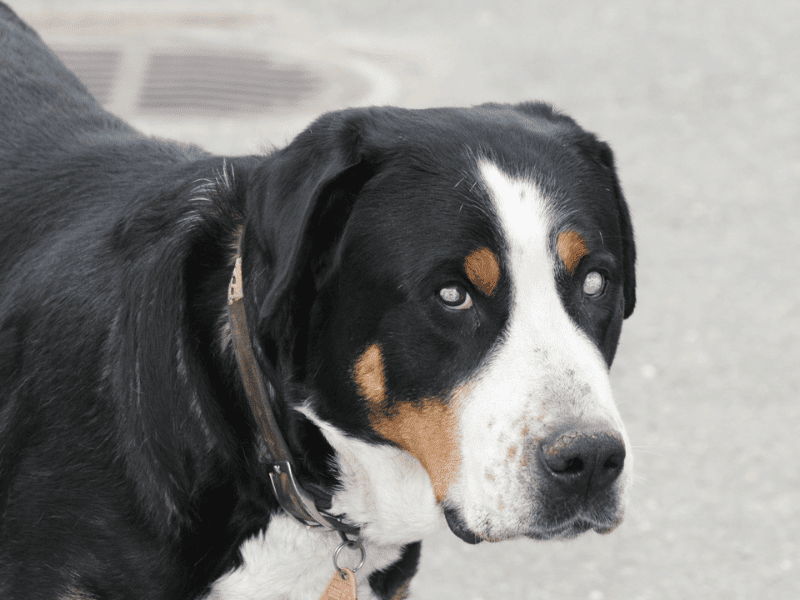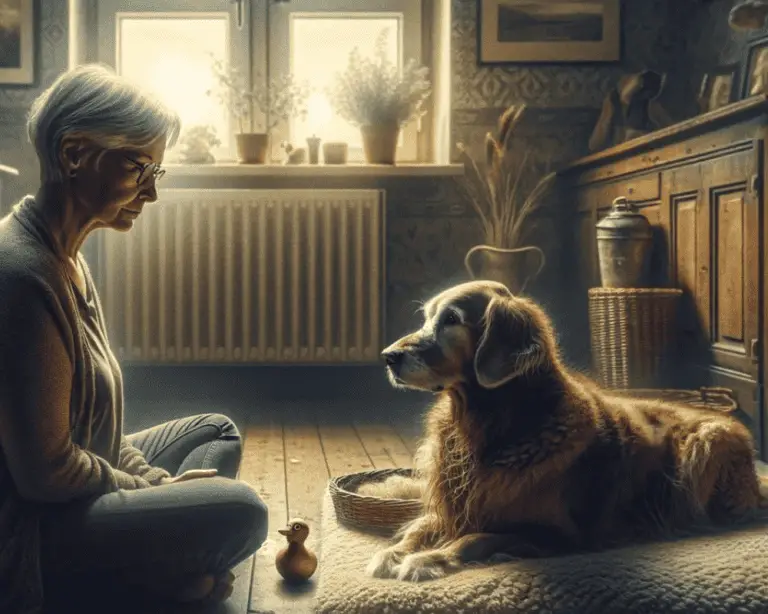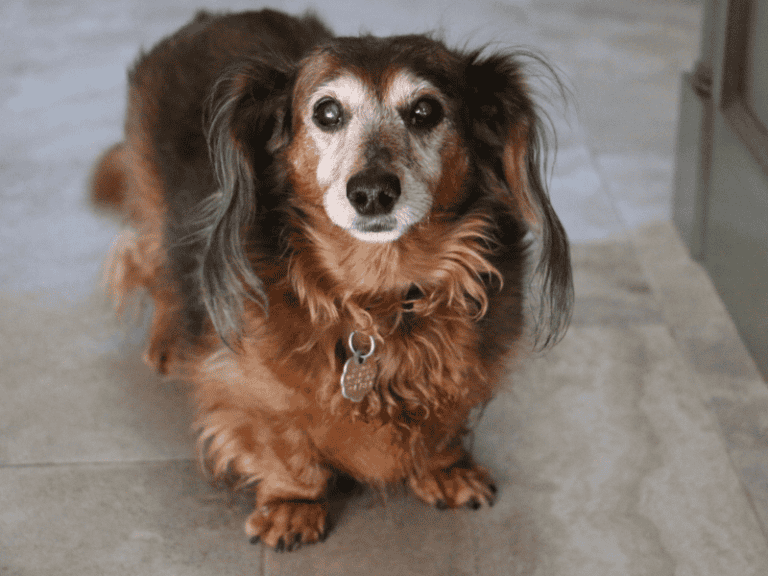8 Tips to Make Life Easier for Your Visually Impaired Senior Dog

The older your dog gets, the more aches and pains he will have. Some are hardly worth mentioning, others have a huge impact on your everyday life. If your senior dog goes blind, that leads to many changes in how you live together.
I have gathered 8 tips in this article on how to handle life with your visually impaired senior. You will learn how to adapt your home to the situation, which activities are suitable for older, visually impaired dogs, and how your dog’s blindness changes your communication.
💡 Tip #1: High-pitched audio cues
The problem with a blind or almost blind senior dog is that he is often hard of hearing too. As dogs age, both vision and hearing often decline. That is why it is all the more important now that you use the right sound signals.
A senior dog is more likely to hear high sounds than low ones. That does not apply to every dog, but it does to the majority. The reason lies in the structure of the ear. The hair cells responsible for low frequencies are under greater strain. As dogs age, they are more likely to bend and become unusable. The hair cells for high frequencies continue to function.
So for your visually impaired senior to hear you, you need to speak to him in a higher pitch. Try it when your dog cannot see you. Say his name at a normal volume and in your usual pitch. If he does not respond, try a higher pitch. He will very likely turn toward you then.
When you speak to your senior dog, adjust your pitch. Experiment to find the range he hears best.
You can also use bells or whistles. The sounds they produce are high-pitched as well, so your dog is more likely to hear them.
💡 Tip #2: Everything in its place
A visually impaired senior needs a tidy home. If he trips over items lying on the floor, he is more likely to get hurt at his advanced age than a puppy would.
That is due to lower bone density. As your dog ages, he breaks down more bone than he can build. The result is bones that fracture more easily.
The issue does not affect all dogs equally and is also influenced by external factors. Still, you can assume that at ten years old your dog’s bones are less stable than they were eight years earlier. So make sure the floor is clear.
By the way, bone density can probably be influenced by diet as well. As Susanne Kern writes in her doctoral thesis, the intake of polyunsaturated fatty acids is directly linked to bone formation.
With the right food, you may be able to keep your senior dog’s bones more stable. You still have to keep things picked up, of course.
💡 Tip #3: Stair safety
If your home has stairs, make sure your dog no longer has access to them. His limited vision, paired with possible age-related confusion, increases the risk of falls. If your dog tumbles down the stairs, he can be seriously injured.
If there are doors that block the stairs, they need to stay closed from now on. Alternatively, install stair gates or baby gates. If your dog goes between floors now and then, it makes sense to block off both sides.
If he is downstairs, he could otherwise walk all the way up to the gate at the top of the stairs. If he trips on the way back down, the gate at the top will not have done any good.
You can get these stair gates for little money. They can often be mounted right at the stairs. You might have to drill two holes in the wall and screw them in. The effort is worth it for the safety these gates provide your dog.
💡 Tip #4: Protect furniture edges
Depending on your senior’s size, it may be necessary to secure furniture edges in addition to stairs. Because he cannot see well anymore, he is more likely to bump into them. I probably do not need to mention that a table edge in the eye is unpleasant.
You have several options for securing them. You can either sand the edges round. Your dog might still bump them, but he will not get injured. Alternatively, there are soft edge guards that cushion the impact.
That saves you from having to sand anything down, or you can use them on items that are not easy to modify.
You could also place a bushy plant in front of especially nasty edges. If your dog walks into the leaves, he will turn away there at the latest and will not come into contact with the edge.
💡 Tip #5: Do not rearrange the furniture
Dogs are creatures of habit. They love rituals, set routines, and a home they know inside and out. Some animals do very poorly with change. Similar to cats, which are known for protest behavior, a sensitive dog might respond to new furniture with digestive issues.
If your senior is almost blind, there is another important point: he needs to memorize his surroundings. Walking from the living room to your kitchen with your eyes closed is probably not a problem for you. You know your home and you know where the tripping hazards are or when you need to go around a dresser.
Now imagine that dresser is suddenly somewhere else. Without eyesight, it is very hard to orient yourself. If changes have to be made, make sure the new furniture is well secured. Plants can serve as buffers here again, or edge guards can be used. Wherever possible, you should avoid changes.
💡 Tip #6: Support your dog during encounters with other dogs
People often say dogs naturally have poor eyesight, but that is not true. Dogs do have a limited color spectrum, as a study by Paul E. Miller and Christopher J. Murphy found. But dogs are excellent at detecting movement and see much better in the dark than humans.
That also helps explain why communication between dogs relies heavily on visual cues. Sure, dogs sniff each other and vocalize when they meet other dogs.
But body language is incredibly important too. Misinterpretations can, in the worst case, lead to conflicts and even fights.
Your blind or almost blind senior is at a real disadvantage here. He can neither send clear visual signals nor interpret those of the other dog. That is why you should never leave your dog to handle encounters with other dogs on his own. The idea that they will just sort it out themselves does not work here. If in doubt, your dog with a disability is at a disadvantage.
So prevent encounters that could become dangerous. Let your dog meet other dogs slowly. Only when you have a good feeling should the two have closer contact.
💡 Tip #7: Halo harness for blind dogs
This tip is especially helpful for seniors who have only recently begun to have trouble seeing. But dogs that have already adjusted can benefit too.
An assistance harness for blind or visually impaired dogs has one special feature: a hoop that goes around the dog’s head. This hoop acts as a buffer between your dog’s nose and obstacles. So your dog no longer runs full speed into walls or, on walks, into trees and streetlights. He is gently stopped and can reorient himself.
At first, the resistance it creates will likely confuse him. But once he has gotten used to it, the harness provides a lot of security. Especially in new environments or outdoors, it significantly lowers the risk of injury.
It also makes it easier for other dog owners to see that your dog has a disability.
There are also yellow bandanas with three large black dots that indicate blindness. When other dog owners know a blind dog is approaching, they can respond much better.
💡 Tip #8: Nose work as enrichment
Seniors want to be kept busy too. If they are also visually impaired, you need activities that fit that. They should be fun for your dog without overwhelming him or putting him in danger.
Nose work is perfect for that. A snuffle mat, for example, can be worked on by a blind senior even while lying down. The tasks do not have to be complicated.
If you have a yard, simply scatter some food on the grass and let your dog search. This activity also works well as a break during walks.
Dogs engage a large area of their brain when they sniff. That keeps them sharp while also making them tired. So you are giving your senior a good workout and, combined with other methods, can slow the progression of dementia.
Conclusion
As they age, dogs can become not only deaf but also blind. Dogs can live well with both limitations. That is partly because they usually retain a small portion of those senses.
They may still see outlines or hear very high tones. And dogs have a very well developed sense of smell that can partially make up for the other two senses.
In old age, the special challenge is the increased risk of injury due to blindness. You should pay particular attention to that. Beyond that, it is not hard at all to make life good for a blind senior.
You will both get used to the new situation.






